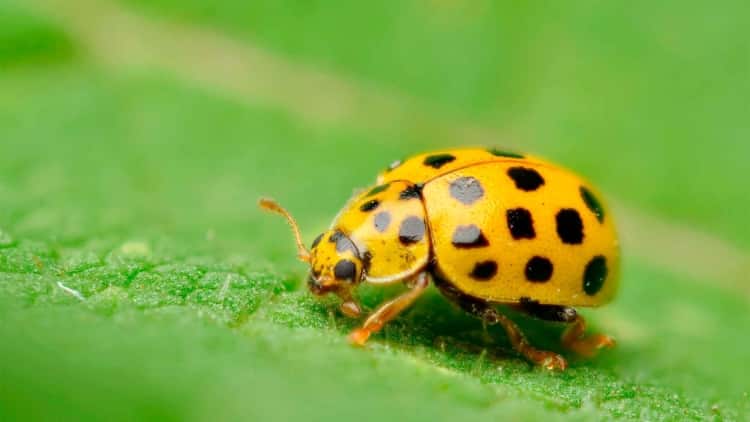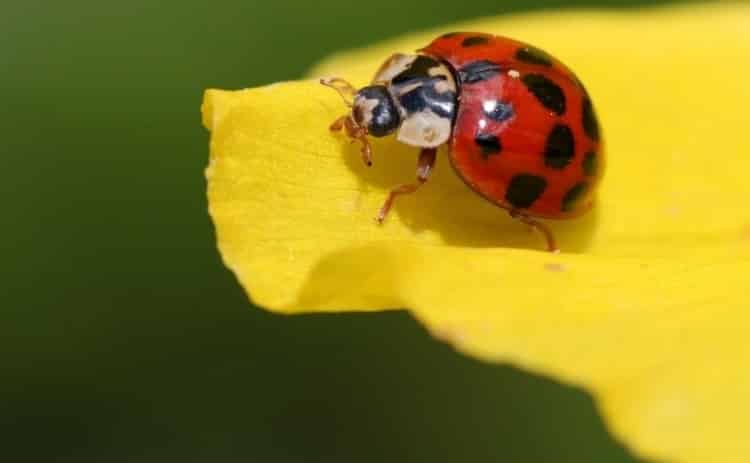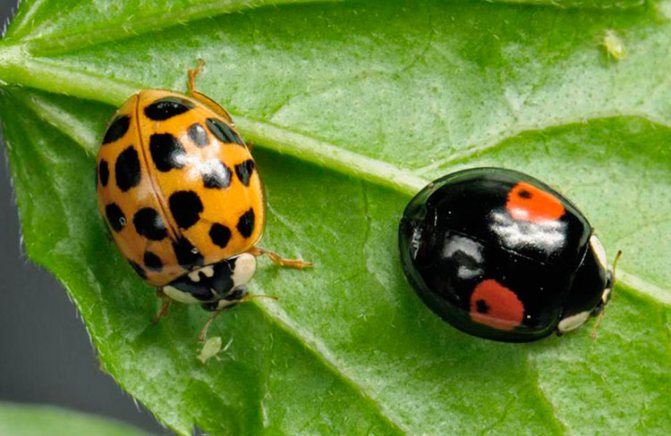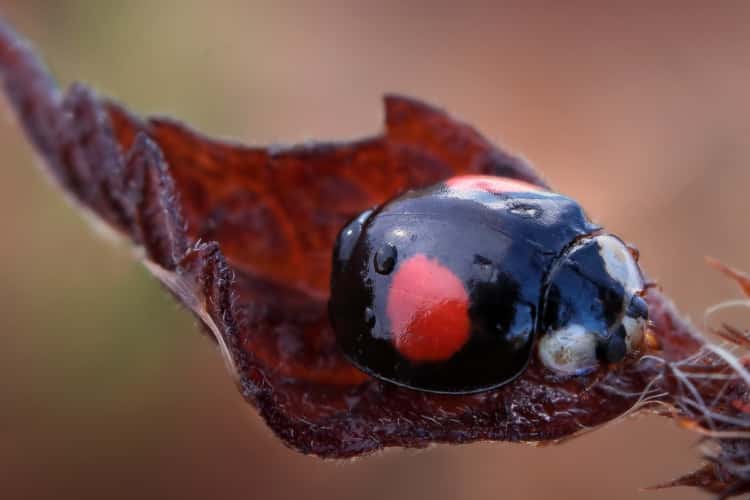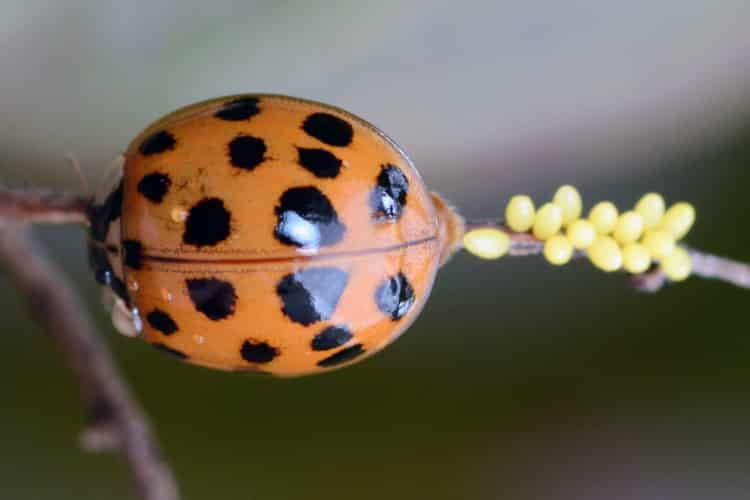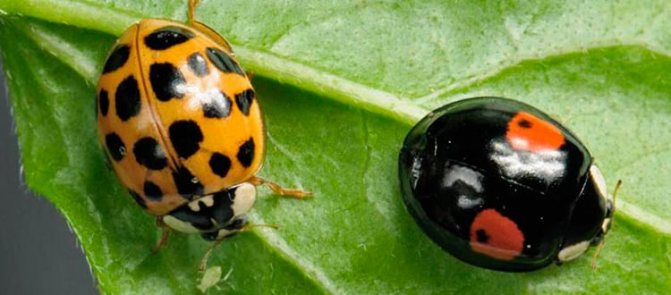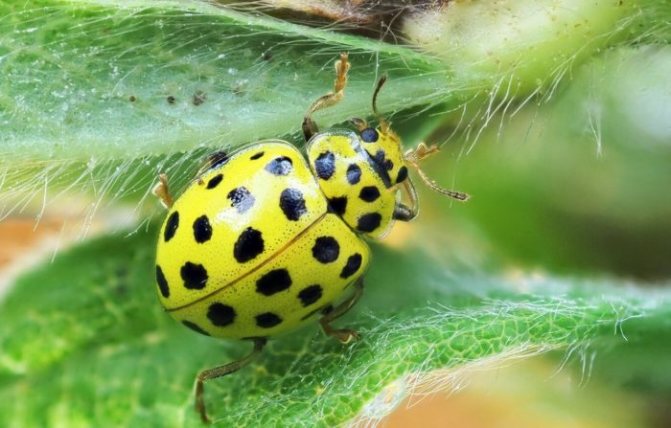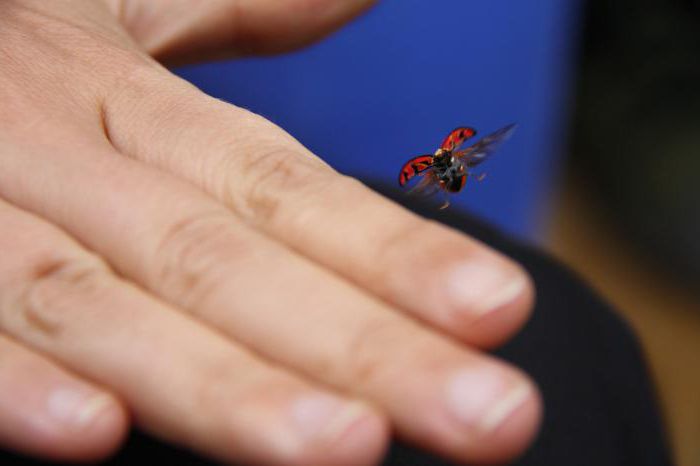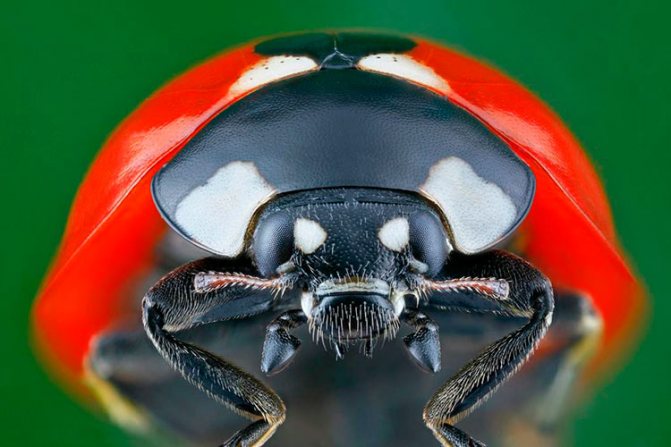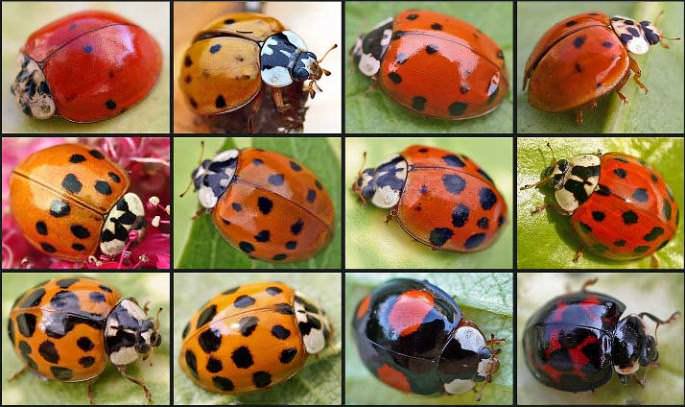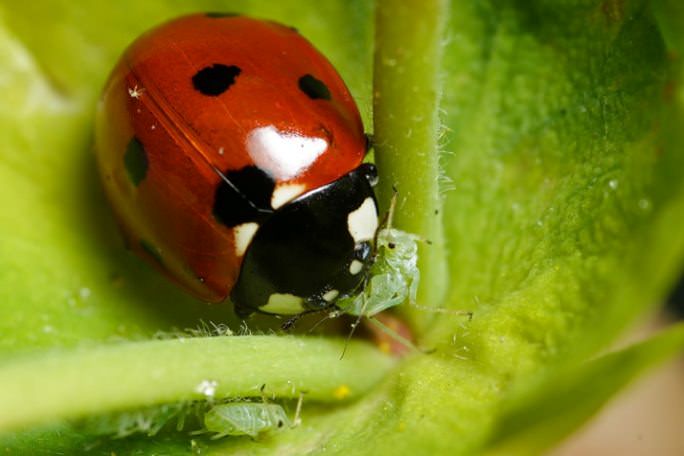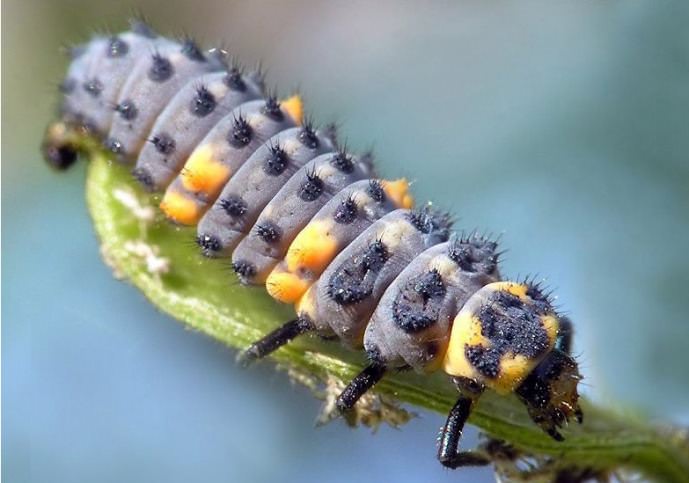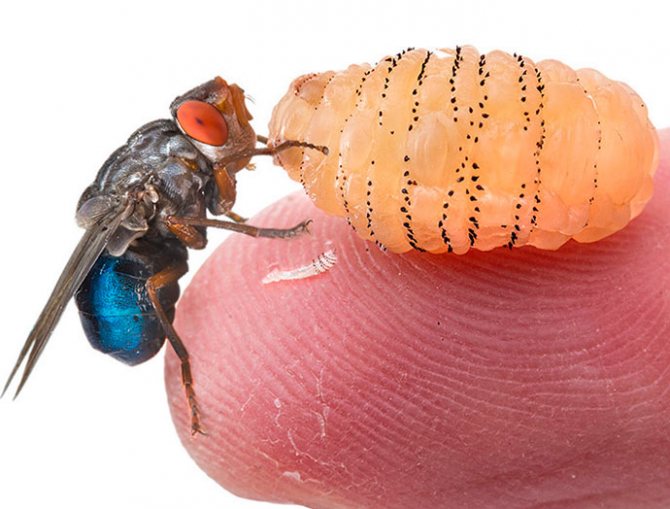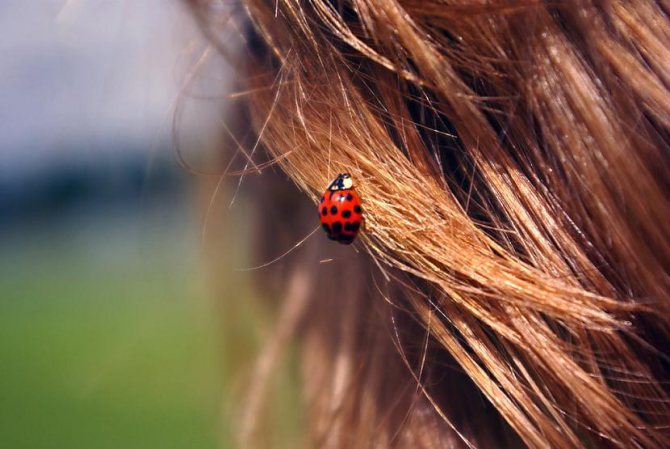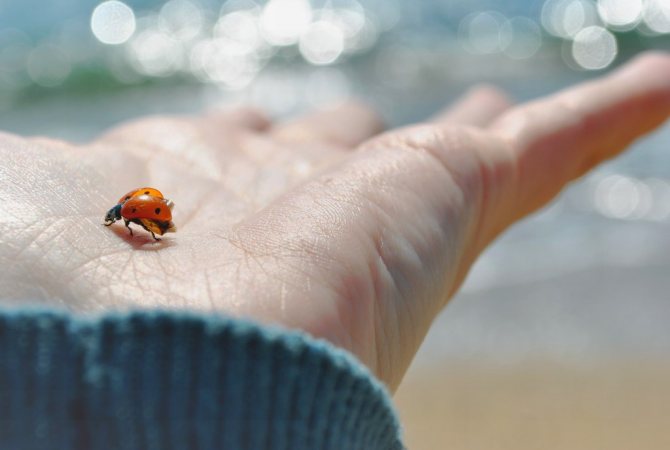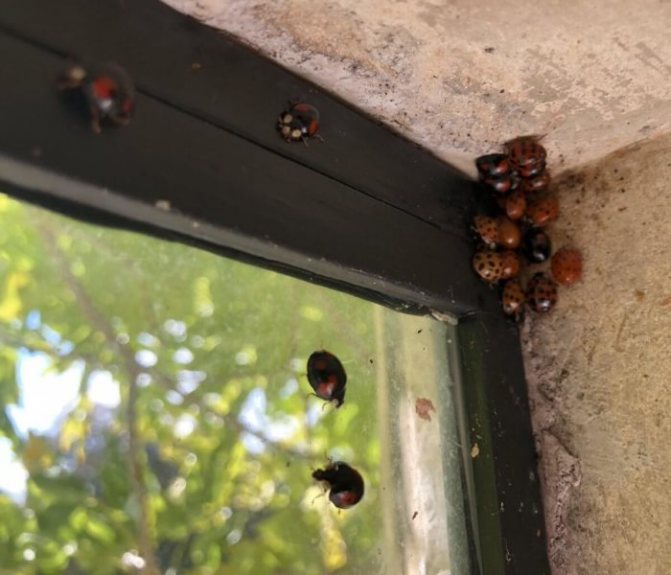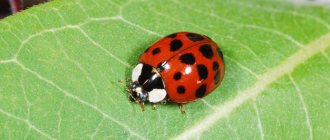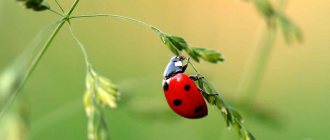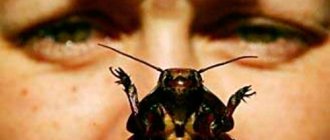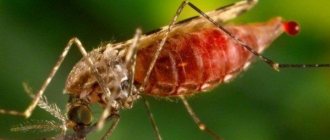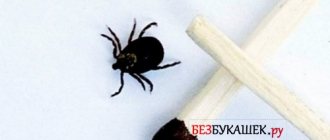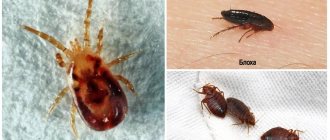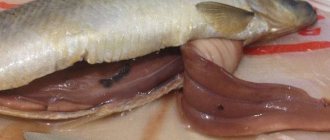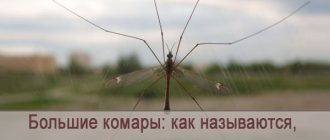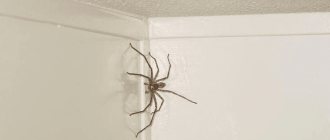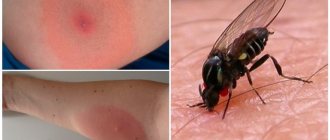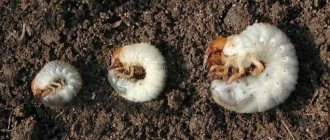Ladybug - the very name of this insect already speaks of something good. Our ancestors believed that it lives in heaven and descends from the sky to give people happiness - it's not for nothing that people in all corners of the world love small red bugs with black dots on their wings. Meeting them is a good omen that speaks of something very good.
There are signs associated with the color of the ladybug.
It is believed that if you see a yellow insect, it will certainly bring happiness and change for the better to a person. Black back with red spots - unprecedented success in your work awaits you. If you see an insect completely without spots - add to the family.
Recommended: Why did the butterfly fly into the house?
If this insect sat on you on the street, pay attention to exactly where it sat:
- The ladybug sank down on your head - to success in work, study, and career advancement.
- On the face - mutual, bright, true love awaits you soon.
- Did the bug sit on your hand? On the right - for good luck in all endeavors, on the left - for financial well-being.
- Tangled in your hair - to resolve a difficult situation and financial well-being.
Where did the name ladybug come from?
The scientific name of the ladybug was due to its unusually bright color - the Latin word "coccineus" corresponds to the concept of "scarlet". And the common nicknames that were presented to the ladybug in many countries of the world speak of the respect and sympathy of people for this insect. For example, in Germany and Switzerland it is known as the "Mary's bug" (Marienkaefer), in Slovenia and the Czech Republic the ladybug is called "Sun" (Slunecko), and many Latin Americans know it as the "Vaquita de San Antonio".
The origin of the Russian name for the ladybug is not exactly known. Some researchers are inclined to believe that this is due to the insect's ability in case of danger to release "milk" - a special poisonous liquid (hemolymph) that scares away predators. And "God's" means meek, harmless. Others believe that these insects got the nickname "ladybugs" due to the fact that they destroy aphids and contribute to the preservation of the crop.
The large family of ladybugs includes more than 4,000 species, divided into 7 subfamilies, which include approximately 360 genera.
The most interesting varieties of ladybugs:
- Two-spotted ladybird (Adalia bipunctata)
A beetle with a body length of up to 5 mm, a dark red elytra and two large black specks. The prothorax is devoid of the anterior carina. The pronotum is black and has a yellow lateral border.
- Seven-spotted ladybird (Coccinella septempunctata)
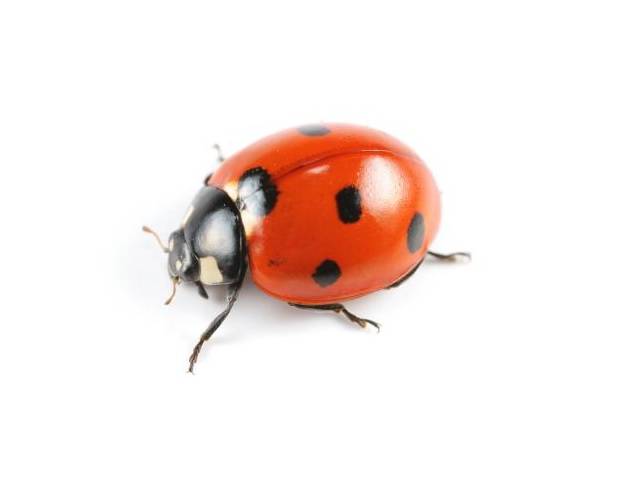
The most common ladybug in Europe. The size of a ladybug reaches 7-8 mm. The elytra are colored red, they have one small white speck (at the base) and three large black ones. The seventh ladybug spot is located on the pronotum (scutellum).
- Twelve-point ladybug (Coleomegilla maculata)
The insect is 6 mm long and has a pink or red elytra with 6 dots on each of them.
- Thirteen spotted ladybird (Hippodamia tredecimpunctata)
The dimensions of the elongated body of adults range from 4.5 to 7 mm.The elytra of a ladybug are colored red-brown. 13 spots stand out on them, some of which merge with each other.
- Fourteen-spotted ladybird (Propylea quatuordecimpunctata)
She has yellow or black elytra with black or yellow dots.
- Seventeen-spotted ladybug (Tytthaspis sedecimpunctata)
The body of the insect is 2.5-3.5 mm long. Usually its color is bright yellow, sometimes it can be darker. These beetles live in Europe.
- Asian ladybug (Harmonia axyridis)
The beetle has a body length of up to 7 mm. There are two subspecies within a species. In one of them, the color of the elytra is yellow with black specks, both large and small. The prothorax is white with a dark pattern. The second subspecies is characterized by a black coloration of the elytra, on which red-orange specks are clearly visible. Prothorax black with light yellow spots. This ladybug species has 19 spots.
- Changeable ladybird (Hippodamia variegata)
Body size up to 5.5 mm. Pronotum black with two yellow spots. On yellow-red elytra, 6 dark spots of various shapes and 1 large spot near the scutellum are clearly distinguished. Margins of black pronotum with yellow border.
- Ocellated ladybird (Anatis ocellata)
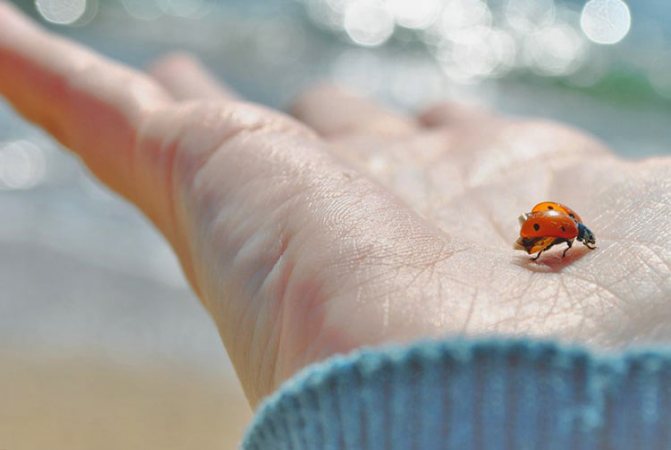

Quite a large insect with a body length of up to 10 mm. The color of the head and pronotum in this species of ladybug is black with small yellow spots. The elytra are yellow or red, each of which has black spots surrounded by lighter rims.
- Alfalfa 24-point ladybird (Subcoccinella vigintiquatuorpunctata)
A pest of agricultural crops. A small bug with a body length of no more than 4 mm in an adult. The whole body of a ladybug is colored red. The elytra and pronotum are covered with 24 small black spots.
- Pointless ladybug (Cynegetis impunctata)
Quite a rare species of ladybugs, whose red or brown body is covered with small and thin villi. The size of the imago does not exceed 4.5 mm. Its elytra and pronotum lack characteristic punctures.
- Ladybug of the genus Sospita
has several types and color variations.
- Ladybug Halyzia sedecimguttata
The insect has an orange elytra with 16 white dots. Lives in Europe and the British Isles.
- Ladybug Anatis labiculata
The insect is white or light gray with 15 black dots.
- There is also a blue ladybug - this is Halmus chalybeus
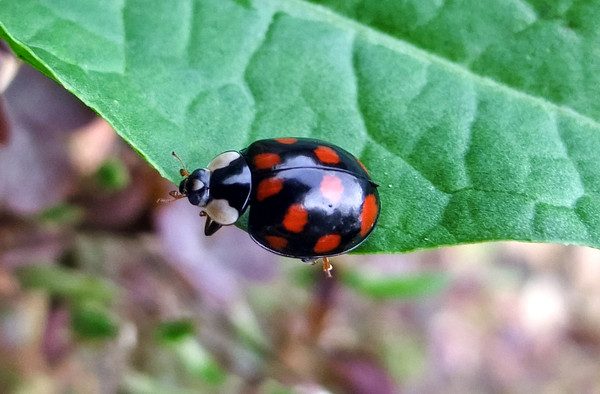

Its elytra is cast with a blue sheen, and its length reaches 3-4 mm. This insect lives in Australia.
Depending on the color
Everyone is familiar with red insects with neat black spots on the back - far from the only species that lives in our territory. In summer, you can easily meet the yellow ladybug. Occasionally encounter black. And with a lot of luck, you will see a brownish bug with white spots on its shell! What does this mean?
In fact, almost no signs based on the colors of the ladybug have come down to us. But dark, gloomy shades have long been considered dangerous, so people prone to superstition are afraid of such an insect. Completely in vain! If you find this "harsh" cutie on yourself, know that you have been visited by the Harlequin - a special subspecies of the ladybug.
True, it differs not only in its unusual colors, but also in its disgusting disposition: it bites painfully, spoils the harvest of berries and, in addition to harmful aphids, is not averse to snacking on its smaller red "relatives". Therefore, a meeting with the "Goth" ladybug can be regarded as a warning to be more careful.
Yellow
The color yellow is sometimes associated with separation, treachery and evil gossip. But this does not concern the heavenly messenger in any way. Yellow ladybugs bring happiness. At least pleasant moments! And if you remember that signs often associate the yellow color of animals and insects with money, then the meeting portends the most favorable changes.
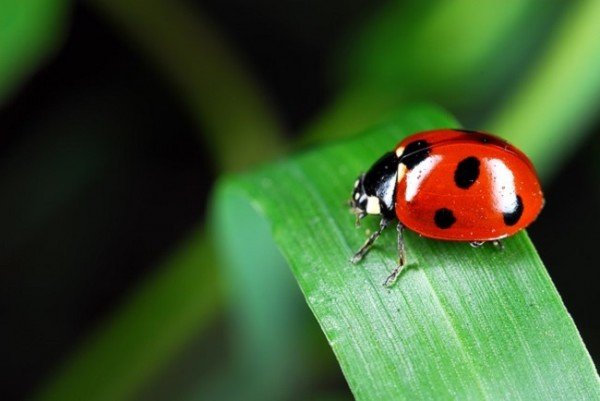

The red bug we are used to is just one of hundreds of species of ladybugs.
With white spots
A rare species of a bug with white spots on a red-brown shell is mystically no different from its red counterparts.All the signs concerning ordinary ladybugs can be safely attributed to him.
Red, black, yellow - does it matter?
Not a single interpretation of the signs of ladybugs is complete without mentioning its color:
- A red insect with black spots, familiar to everyone from childhood, "speaks" of pleasant little things that will help to cheer up, drive away sadness, and cause a smile.
- A yellow ladybug is an omen of some happy events. They can relate to personal life, financial matters, some important undertakings.
- The red-brown beetle promises to receive important news in the near future.
- Against the background of the rest, black ladybugs stand out, in relation to which there is the same opinion as about black birds or cats. Meeting with them does not bear direct negative consequences, but serves as a warning of possible difficulties or dangers.
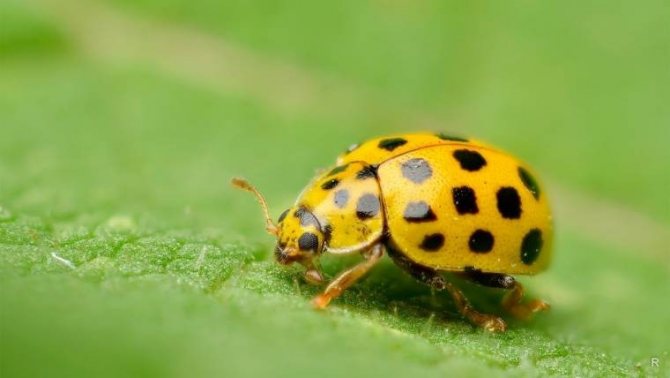

Ladybug: description, characteristics, photo. What does an insect look like?
The size of a ladybug ranges from 4 to 10 mm. The body shape of insects is almost round or elongated-oval, flat below and strongly convex above. Its surface in some species of ladybugs is covered with fine hairs.
We invite you to familiarize yourself with the Red caterpillars in the apartment
In the structure of the body of ladybirds, the head, pronotum, chest, consisting of three sections, three pairs of legs, abdomen, and wings with elytra are distinguished. The insect's head is small, motionlessly connected to the prothorax and, depending on the species, can be slightly elongated. Ladybug eyes are relatively large. Antennae, consisting of 8-11 segments, are very flexible.
Insect pronotum convex, transverse, with notch at the anterior margin. Often there are specks of various shapes on its surface. In contrast to the fore- and mesothorax, which are elongated across the body of the insect, the shape of the metathorax resembles an almost perfect square.
In total, ladybirds have 6 legs, which are of moderate length. In the structure of each paw of an insect, three obvious and one hidden segment are distinguished. With their help, the insect can move quite quickly on the grass or plant stems. The abdomen of ladybirds consists of five to six segments, covered from below by sternites (segmental semirings).
Ladybugs fly with the help of two rear wings.
The front wings of the ladybug in the process of evolution have transformed into rigid elytra, which serve as protection for the main pair during the period while the ladybugs are on the ground.
As a defense against predators such as birds, ladybugs secrete cantharidin, a poisonous yellow liquid that has an unpleasant odor.
In addition, the bright coloring of the ladybug also scares away potential enemies from her.
The color of the protective covers of the ladybug can be bright red, deep yellow, black, dark blue or brown with spots of black, yellow, red or white in various configurations.
In some species of ladybugs, these spots can merge into abstract patterns, in others they are absent altogether. Often the pattern on the pronotum is a sign by which the sex of the ladybug can be distinguished.
Almost no animal or insect is capable of harming members of the family. However, there is an enemy against which the bright color and poisonous hemolymph of ladybirds is powerless. These insects are called dinocampus. They choose places for laying their eggs in the bodies of pupae or adult ladybirds. In the process of development, parasites destroy their host.
Flew into the house
The little wanderer in the apartment is always for good.
- If a spouse lives in the house who have long dreamed of a child, their dream will soon come true.
- If there are enough children in the house, but discord reigns between family members, the visit of a little bug should fix the matter.It is especially good to find a ladybug on the bed: all quarrels and mutual reproaches between spouses will stop.
- If an insect flew into a girl's room, after a while she should get married or start a new romantic relationship.
- Sign often changes depending on the season. For example, in spring and summer, a ladybug in an apartment promises a monetary profit, and in autumn, a replenishment of the family.
- If by some miracle you find a bright red bug in your house in the middle of winter, the belief promises grandiose and, no doubt, happy changes in your life. Of course, it may be that the ladybug fell into hibernation somewhere in a dark corner of your apartment, and in winter it warmed up and woke up ahead of time. But is this a reason to be discouraged? If you feel the need to change something, take action, and luck will find you. Just do not try to throw the messenger of happiness out into the cold!
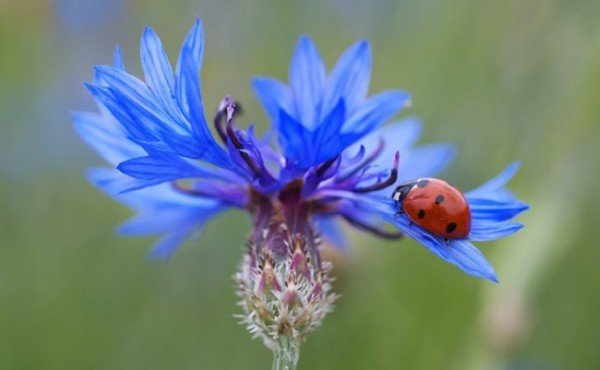

Do not forget to count the specks on the back of the insect
The best messengers are ladybugs with seven points on the back. But even three points, in which case, your expectations will not disappoint.
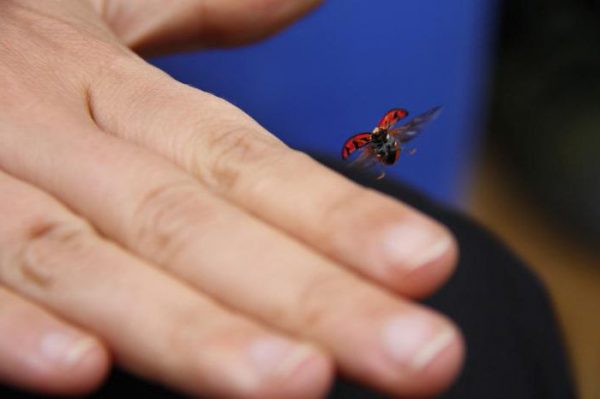

Ladybugs often fly into homes and always bring good news and positive changes with them.
If a ladybug flew into an apartment or onto a balcony and crawls along the walls or ceiling, then the exact interpretation of this sign depends on the circumstances under which the little guest was seen in the house, as well as on the time of year:
- in spring time, such a sign promises monetary profit and financial well-being;
- in the summer, the insect brings with it career growth and success in work;
- in the fall, the appearance of a spotted bug in the house indicates the imminent birth of a child, and if there are children in the family, then there will be complete harmony and mutual understanding in the relationship between household members;
- in winter, after such a visit, one can expect a marriage of a family member or the arrival of a distant relative.
It is considered a good sign to meet this bug crawling on a children's bed or on a matrimonial bed. It means that the child will grow up healthy and happy, and all quarrels between husband and wife will stop, and they will live in complete harmony. If there is a patient in the house, such a visit portends him a speedy recovery.
Why a bat bite is dangerous
Small winged animals can hurt badly. These are not aggressive animals, but when frightened, bats can attack a person, defending themselves. Sharp teeth are not the only threat. Infected individuals can transmit the deadly virus to humans.
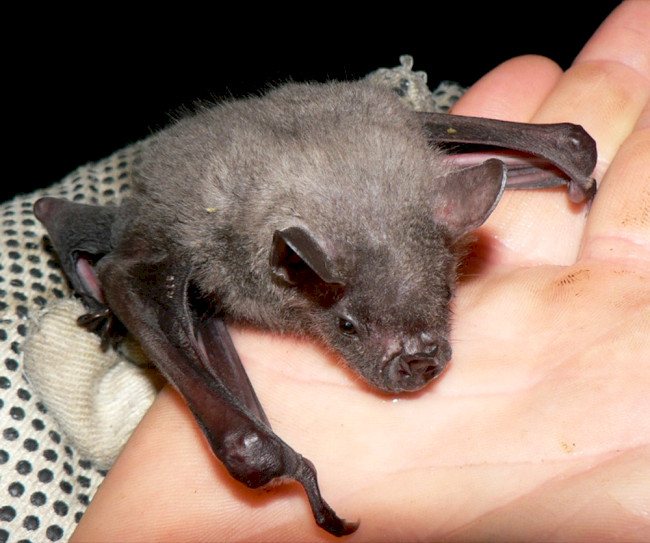

If a colony of nocturnal mammals has settled near the house, do not worry too much. The rabies virus is not transmitted from one animal to another, therefore, the accumulation of nocturnal animals in a residential area does not pose a danger to people. On the contrary, in large colonies, bats develop immunity to disease. The risk of infection is low. But still he is.
After being bitten by a bat, it is recommended that you immediately go to the first-aid post.
A doctor's consultation is required if one of the following symptoms is present:
- redness and itching at the site of the wound;
- insomnia;
- prolonged temperature rise;
- severe headaches;
- excessive irritability;
- fast fatiguability;
- nausea;
- lack of swallowing reflex;
- painful reaction to light;
- hallucinations.
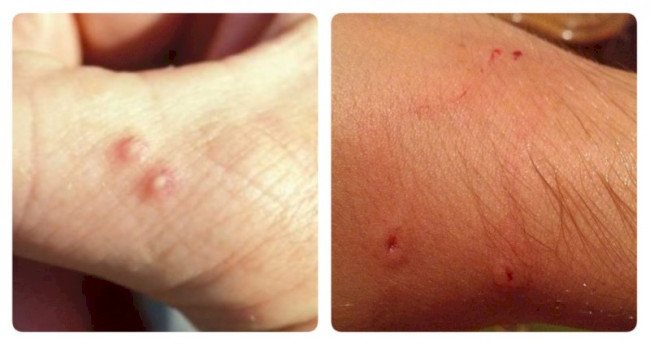

All these signs may indicate a rabies infection. To cope with the disease is possible only with the help of medicines.
The first symptoms may appear 10 days after the bite. In some cases, signs of rabies appear 2 months after contact with infected individuals.
Blood-eating winged mammals are not found in Russia. Bats bite when they sense danger.
Sat on a person
Not every meeting with a ladybug is arranged by higher powers.Agree, if a small bug lands on you in the middle of a meadow or while relaxing in the village, there is no point in wondering what it would be for. Much more amazing if not a single insect dived at you! But when a ladybug appears literally out of nowhere in the middle of the urban jungle, or you repeatedly encounter persistent bugs in the most unexpected places, you can try to analyze their behavior from the point of view of superstition. Let's try ...
On the head
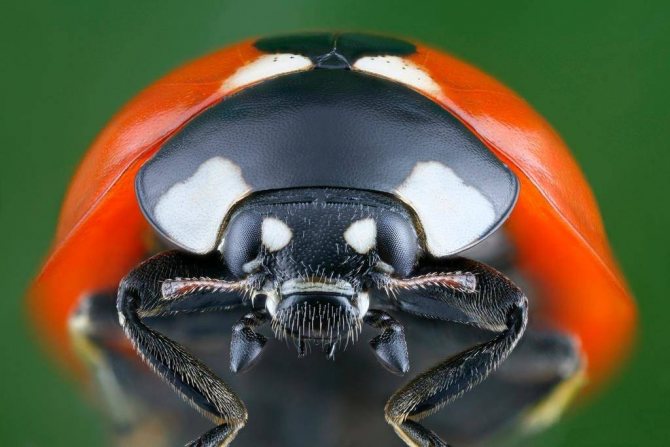

An insect perched on the top of the head is a very happy sign. Great luck is being sent to you! Career will go forward with leaps and bounds, authority will grow, and if there is some unpleasant situation, after a short time it will be resolved for the better. But it is very important that you, being frightened, do not sweep the ladybug to the ground, or the happy load that she was carrying will not reach you.
On the shoulder
A red beetle with black dots on the shoulder is a neutral omen. Nothing significant will happen to you, but your health and mood will rise. And there will be more pleasant events in life. By the way, it is believed that a tattoo of a cute insect on this particular part of the body gives a person wisdom. Was this why the ladybird came to visit you to help you make a decision?
On hand
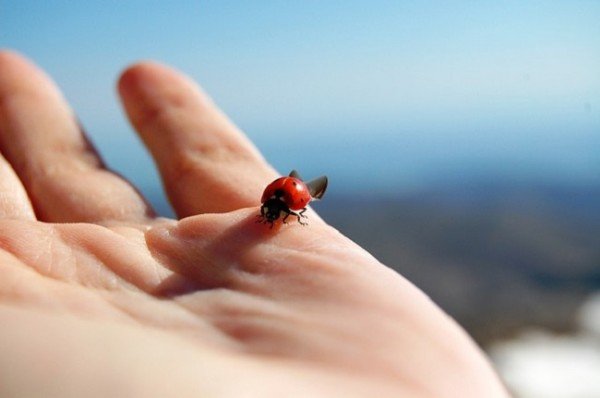

Make a wish rather!
- A ladybug on your hand is a great reason to tell fortunes for the future. Ask the insect any question and blow gently under the wings. If the bug flies up, the wish will come true. He will continue to wander thoughtfully through his hand - he will have to wait a little with the execution of the plan.
- For a girl, a ladybug in the palm of her hand can serve as a good navigator. The algorithm of actions is the same, only instead of pestering your random passenger with extraneous questions, ask her to show the way to the betrothed's home. And watch in which direction the insect flies.
- If the prognosis of the ladybug turned out to be unfavorable, do not be discouraged. It is believed that these babies are reluctant to fly when they anticipate rain. Perhaps neither the betrothed nor the cherished desire has anything to do with it - your guest simply refuses to fly away from a warm hand in bad weather.
We invite you to familiarize yourself with Red worms in fish
On foot
Is a ladybug crawling on your leg? Superstitions on this score are silent. But since this insect portends only good things, then you don't have to worry, your happiness will surely find you. Especially if you don’t forget to count to 22. Some believe: if the bug goes flying before the last digit sounds, the good omen will not work, after it it will definitely come true.
If this cute creature sat on a person, you need to pay attention not only to his appearance, but also to the part of the body that she chose.
In this case, all "enemies" at work will be defeated, troubles will be left behind, and honor and respect can be expected from colleagues and bosses.
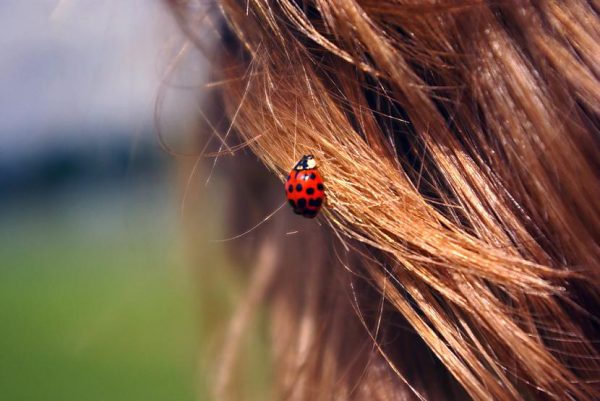

If a ladybug sits on her head, a person can expect a promotion, a meteoric rise in the career ladder and business success.
On the face
A spotted bug that sat on the face or neck of a lonely person portends an early meeting for him, which can become fateful and start a new stage in life. If he has a lover or beloved, then the relationship between partners will be just perfect, and quarrels and misunderstandings will be left behind.
On hand
First of all, you need to look at which hand the bug landed on:
- The right hand means that a person will soon have a cherished wish - to be sure of this, you need to whisper what you have planned to the insect, and then slightly blow on it. The dream will come true if the ladybug immediately spread her wings and flew away, and if she continues to crawl, you will have to wait with the realization.
- The insect sits on the left hand to a significant improvement in health, which is especially important for people suffering from any diseases.
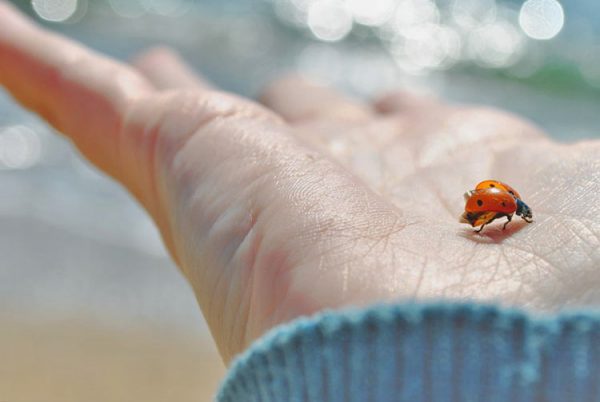

With the help of this little bug, you can try to find out your future - it is believed that it understands human speech and can tell you what events to expect in the near future
On the shoulder
A ladybug sitting on a person's shoulder is considered a neutral omen - it does not portend bad or good events. True, if the bug changes its mind and crawls to another part of the body - for example, to the stomach, you can expect good luck and positive changes in life. Another interpretation of this omen is the support that loved ones will provide in a difficult situation.
On foot
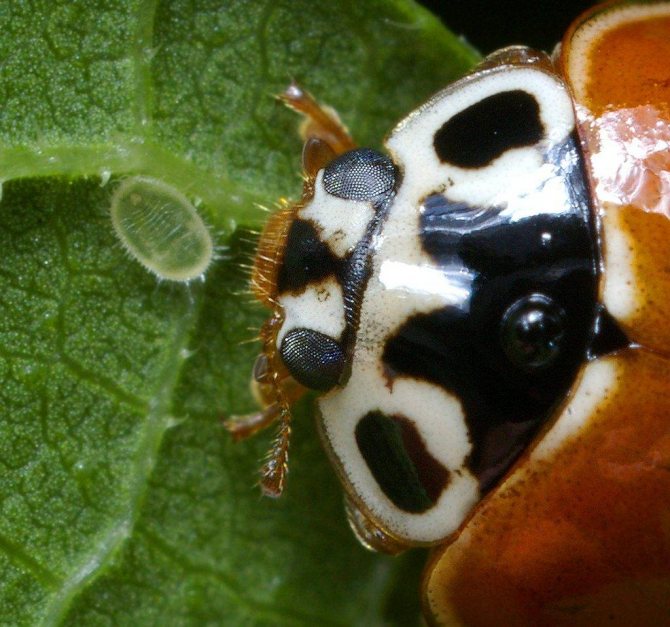

If this bug sits on its leg, it means that serious obstacles may arise in achieving the goal, but you should not lose heart - you just need to wait for better times and everything you have planned will come true.
On the back
A spotted insect sitting on its back portends that the difficult situation that exists at the moment will soon be resolved in the best possible way. If a person has no problems, then the ladybug simply promises happy changes in life and a smile of fortune.
On clothes
The messenger of heaven, who sat on the clothes, brings good luck and pleasant surprises with her, and most likely they will come from a loved one.
So, we figured out which ladybugs can bite painfully - 28 spots and Harlequin. Among the rest of the ladybirds, no cases of bites were recorded. Only an imperceptible and even almost imperceptible pinch of the skin is possible, which a person will not even notice. What to do to avoid a ladybug bite - do not take unfamiliar insects in your hands, but it is better not to touch insects at all.
What is the difference between a 28-spotted ladybug and an ordinary harmless ladybird - spots, they are small and there are a lot of them. Harlequin is a large ladybug with a burning black head with bright white spots, bright orange or pale yellow color is visible on its wings. The main difference is white spots on the head and uneven black large ones along the wings.
Reza Rezamand, 31, said he developed sepsis after a ladybug bit him in the leg. The leg was swollen and the toes turned black. The doctors said that with a 70% chance he would not survive. But they were able to cure him with antibiotics after numerous tests.
Such cases practically do not occur, moreover, it is not known whether the bite of a small insect worked this way, or the reason was completely different.
Why are they dangerous?
An unpleasant appearance and a tendency to gather in a colony provided these arthropods with a bad reputation (here you can find a description of wood lice and their classification). What harm, besides a feeling of disgust and the possibility of provoking a nervous breakdown, do woodlice carry?
For man
Are crustaceans dangerous to humans? Woodlice are incapable of biting, spoiling food, contaminating water, buzzing or entering the body, which makes them practically harmless to humans.
However, due to the fact that these arthropods eat not only living parts of plants, but also rotted and dead microorganisms, there is a risk that wood lice can carry various infections and pathogenic plants on their paws. The possibility of wood lice spreading infections is a controversial issue, since there is no scientific evidence for this.
You can read about the diet of woodlice, its types, including the white pest on our website.
For pets
For pets, as well as for humans, wood lice do not pose a threat. Moreover, the owners of spiders or reptiles can specifically engage in breeding wood lice, since these crustaceans are the best source of protein for them.
For plants
Woodlice are most dangerous for indoor plants. Arthropods eat living leaves, damage and disrupt the integrity of the root system.
In addition, the presence of wood lice in a flowerpot with a plant leads to the fact that the soil is deprived of oxygen and becomes too dense.
Important! The appearance of small holes on the leaves and flowers is a sign that the plant has been attacked by woodlice.
If you do not get rid of the pests, in 14-15 days the house plant will completely wither and die.
In the case when crustaceans start in the cellar, they spoil the potatoes and stocks of other vegetables, and in the greenhouse - only the sprouts of vegetable crops that have hatched, which will affect the harvest.
For housing
As a rule, wood lice live under the bathroom, behind the toilet, near the boiler, in cellars and pantries where stocks of vegetables are stored. The choice of these places is associated with high humidity and the presence of the necessary food (you can find out more about the nutrition of wood lice living in the bathroom, apartment and other premises here).
Despite the fact that wood lice do not parasitize on people or pets and cause the greatest harm only to indoor plants, the very neighborhood with these pests and the appearance of their large accumulation in the corners and on the walls of the bathroom is very unpleasant and requires immediate disposal of them.
The most dangerous for an apartment are wood lice, which penetrate the room through the ventilation system from the basement, from the roof or the street. Such arthropods reproduce quickly, it is difficult to fight them.
Where do ladybugs live?
The distribution area of ladybirds includes all continents of the globe and all climatic zones, with the exception of Antarctica and areas covered with eternal snow. You can meet these insects in all countries of Northern, Western and Eastern Europe: Sweden and Norway, Denmark and Iceland, Great Britain and France, the Netherlands and Germany, Italy and Poland, in all countries of the former Soviet Union.
Some types of ladybirds prefer to settle only those plants on which a colony of aphids has developed, others prefer sedges and reeds growing along water bodies and rivers as dwellings, while others need field grasses for their existence.
Regardless of the species, ladybugs lead an isolated lifestyle, gathering together only during the mating season, flights or wintering.
All species from the family of ladybugs are thermophilic insects, therefore, most individuals living in temperate latitudes, on the eve of the onset of cold weather, gather in huge flocks and fly off to winter in countries with a warm climate. However, there are also sedentary insects. They wait out the winter cold, huddled in huge communities, the number of which can reach 40 million individuals.
In this case, the total weight of a flock of ladybirds can be several tons. As a shelter from unfavorable conditions, insects use the breakdown of stones, fallen bark and foliage of trees. But ladybugs don't live long. With sufficient food supplies, the lifespan of ladybirds can reach 1 year, with a shortage of food, this period is reduced to several months.
Bit
Did you think the cute bug of your childhood can't bite anyone? How can she, because the ladybug is a hardened predator, leading a continuous hunt for aphids. She has jaws, and quite powerful. Another thing is that for a person the bite of this insect is no more painful than a mosquito bite, and the crumbs show aggression extremely rarely.
- A ladybug "attacking" a person warns of an enemy. Someone is slandering you behind your back or openly trying to slander.
- The insect didn't like your smell and reacted to it in such an unusual way.
We offer you to familiarize yourself with Peroxide from midges in flowers
What is strictly forbidden to do when bitten
In feature films, where there are scenes of encounters with snakes, false information is often provided, which determines the wrong behavior.


After a snake bite, and the clinical manifestations of the symptoms of a bite, it is strictly forbidden to act like the hero of the film, and to carry out the following actions:
- apply a tourniquet over or under the bite site;
- cauterize bites with open fire;
- use a solution of potassium permanganate for disinfection;
- make incisions in the skin with improvised means;
- drink alcohol to neutralize the poison.


High-quality and effective first aid for a snake bite involves the obligatory appeal to specialists for qualified help.
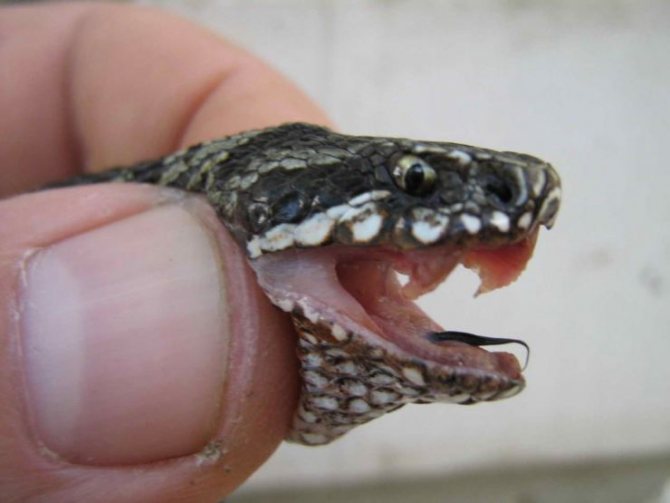

When going out into the countryside or out of town, to the country house or to the forest, you should have an inexpensive set of medicines with you that will help alleviate the condition of the victim:
- pain relievers;
- antihistamines;
- cardiovascular medications.
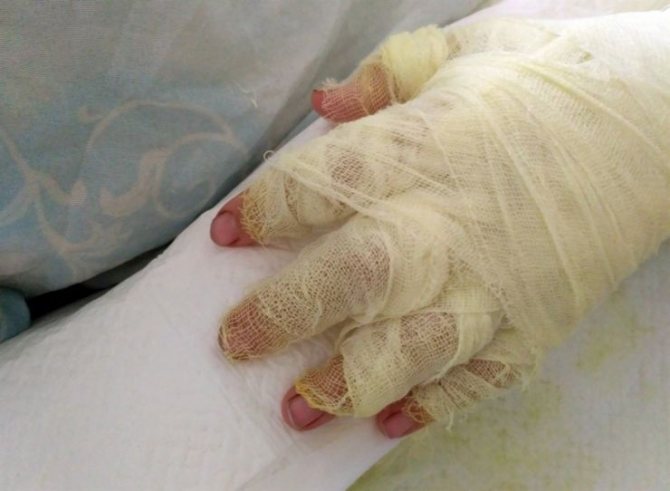

These medications are inexpensive and can help maintain the well-being of the person who has been bitten by the snake and help prevent negative health effects.
See in the cemetery
In ladybirds, as in butterflies, they saw the embodiment of the souls of the dead. Therefore, even in the darkest and saddest places, they were not credited with the ability to bring bad news. Tradition advises to consider the ladybug you meet at the cemetery as a greeting from the “other side” of someone who cares about you and wishes you well.
Meeting a spotted bug on the street or finding it in the grass is a very good omen. Such a meeting indicates that a person can look to the future with confidence - only happy and joyful events, good health, financial well-being and good luck in his personal life await him. By the way, this superstition has a scientific basis - ladybugs are used by scientists as indicators of environmental pollution, and if bugs are often found on the street, then there is no need to worry about the environmental situation.
What to do after an insect bite
An insect bite requires first aid. As a rule, this applies to dangerous representatives of arthropods or the presence of allergies in the victim.
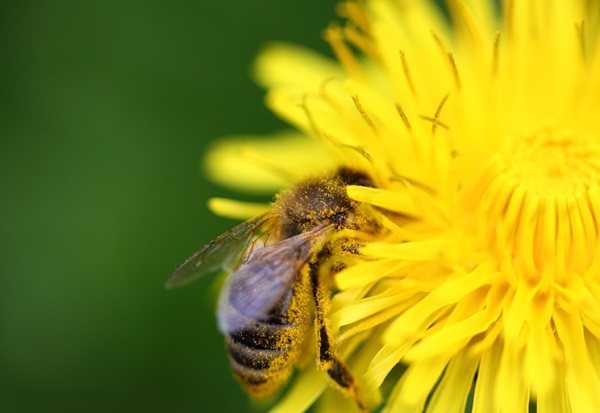

First aid for insect bites
Regardless of what type of parasite is bitten, the following activities (PMP) must be carried out:
First of all, it is necessary to distinguish wounds and abrasions from insect bites, if possible, determine which parasite is guilty. Smear the wound with disinfectant
This will prevent the development of infection and suppuration. If there is a sting after a bite, it must be carefully removed with tweezers. To remove swelling, you should apply cold to the body for a quarter of an hour. The area where there is hyperemia, pain, itching should be treated with an antihistamine (antiallergic) drug - Fenistil gel. An antihistamine must also be taken in tablets (Tavegil, Suprastin, Diazolin). Drink plenty of fluids. The appearance of allergy symptoms after stings of bees, wasps, fleas, spiders and other insects requires an immediate call to the medical team. Individual recommendations depending on the type of arthropod:
Individual recommendations depending on the type of arthropod:
Wounds from a bee sting should be anointed with peroxide, alcohol or a solution of potassium permanganate. With a flea bite, it is important to get rid of severe itching, otherwise you can comb the body until it bleeds - in order to relieve the symptom, it is necessary to smear the wounds of the child and adult with soapy water or a disinfectant, then apply hormonal ointment with hydrocortisone or a drug with an antihistamine effect (Psilo-balm). Sulfuric ointment will help to eliminate inflammation and dry the pathological area, and Advantan ointment is also good against the inflammatory process. The appearance of symptoms of intoxication with an insect bite requires the intake of enterosorbents (Smecta, Enterosgel). The body after bug bites must be treated with a solution based on soap or soda, propolis tincture (will help remove itching).Mosquito bites require the treatment of the skin with a diluted solution of ammonia.
Treatment after an insect bite
After the victim has received the necessary assistance at home, it is advisable to bring the patient for a consultation with a doctor. Insect bites can be fraught with dangerous consequences and diseases, therefore, at the slightest suspicion of a worsening of the condition, it is worth contacting a healthcare facility.
To treat the pathology, doctors will prescribe hormonal agents (creams and ointments). These drugs will remove not only the inflammatory process, but also pain, itching, burning, swelling and other signs of an allergic reaction.


It is also necessary to use antihistamines:
- local action - Fenistil, Elokom, Advantan;
- tablets - Tavegil, Loratadin, Suprastin.
What to do if an insect bite is swollen and reddened
Most of the victims are interested in what to do if redness and swelling appear after an insect bite. This is usually how an inflammatory reaction and an allergic reaction appear. If the brightness of the signs progresses, you need to get qualified help.


Severe swelling and hyperemia after a bite require an appointment:
- drugs to combat an allergic reaction - antihistamine tablets, ointments and creams;
- hormonal agents;
- ointments based on antibacterial components.
If there are many


The more 'heavenly messengers' the better
- The appearance of many bright red bugs in the green grass predicts a large and friendly family to the lucky one who sees them. There is an additional reason to look to the future with hope.
- For farmers in the old days, the dominance of ladybirds in the meadows was a happy omen. Every owner knew that this year the rye would be thick and tall.
Don't try to look for a mysterious background in every microscopic event in your life. A ladybug is only considered a sign when its appearance or behavior is very unusual. And even here the reason may turn out to be the most prosaic - disturbed ecology, climate change, chemicals sprayed somewhere nearby ... But if you still decide that an insect with a bright shell came to you for a reason, be sure to release it in peace. And after that, everything will turn out fine for him and for you.
How do ladybugs breed? Development stages of a ladybug
Individuals of ladybirds reach sexual maturity between 3 and 6 months of age. The breeding season for ladybirds begins in mid-spring. Having gained strength after coming out of hibernation or flight, they start mating. The male finds the female by the specific smell that she emits during this period.
The female ladybug lays eggs on plants near the aphid colony to provide her offspring with food. Ladybug eggs, attached to the underside of the leaves, are oval in shape with slightly tapered tips. Their surface can have a wrinkled texture and can be yellow, orange or white. The number of eggs in a clutch reaches 400. Unfortunately, after the mating season, female ladybirds die.
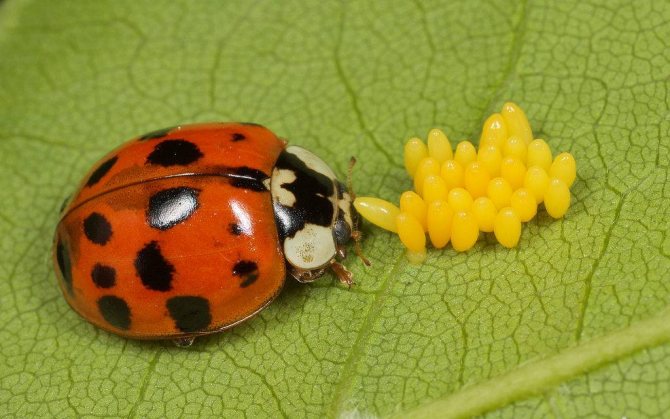

Ladybug eggs
After 1-2 weeks, variegated oval or flat ladybug larvae appear from the laid eggs. The surface of their body can be covered with fine bristles or hairs, and the pattern on the body is formed by a combination of yellow, orange and white spots.
In the first days of their life, the larvae eat the shell of the egg from which they hatched, as well as unfertilized eggs or eggs with a dead embryo. Having gained strength, the larvae of ladybirds begin to destroy the colonies of aphids.


Ladybug larva
The larval stage of insect development lasts about 4-7 weeks, after which pupation occurs.
The pupa is attached to the leaf of the plant with the remains of the exoskeleton of the larva. During this period, all parts of the body characteristic of the insect are laid.After 7-10 days, a fully formed adult individual emerges from the cocoon.
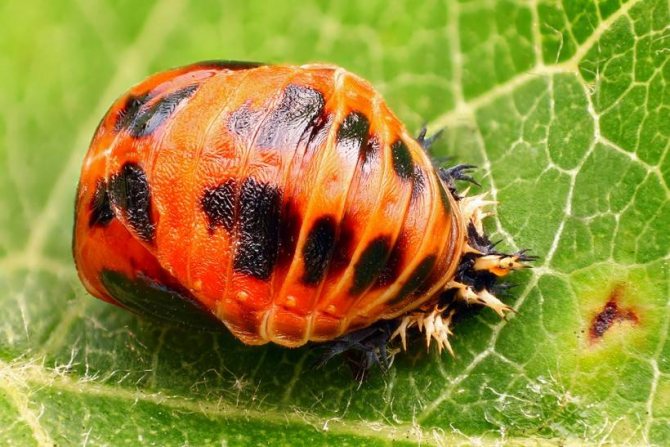

Ladybug chrysalis
How to remove a gadfly larva from under the skin?
Removal of the larva can be done in two ways:
- surgical;
- medication.
The main objective of any method is the safe removal of a foreign body. The removal operation is performed under sterile conditions. The affected area is treated with an antiseptic (iodine, potassium permanganate). A drop of sterile oil will help block air from reaching the larva. She, finding herself in unfavorable conditions, will begin to crawl out of the body on her own. The parasite is pulled out with tweezers or a special clamp.
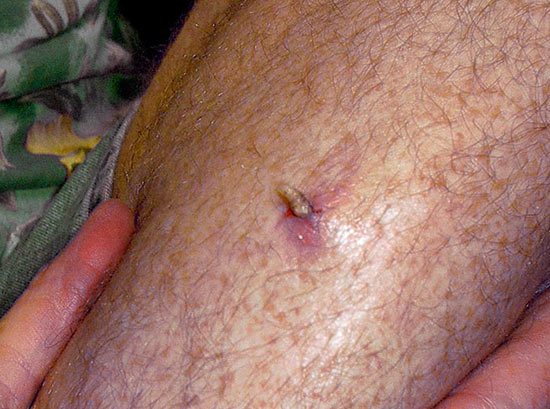

The larva crawls out from under the skin in the leg.
After extraction, the wound is treated and then bandaged with a sterile napkin.
The operation should be carried out by a specialist, since with self-extraction, parts of the parasite may remain under the skin, which will cause inflammation and suppuration of the wound.
The safest extraction is to allow the larva to leave the host's body on its own. To do this, use ointments, creams and oils to remove parasites.
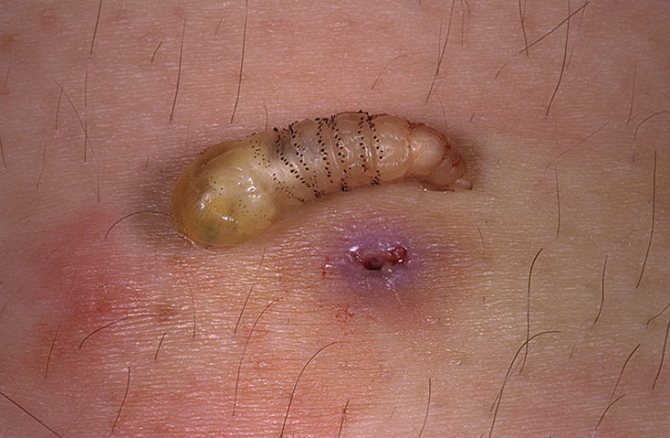

The extracted larva and skin lesions.
The course of drug treatment will allow you to provoke the exit of a foreign object by acting on it through its power source - blood. Such preparations contain substances that are toxic to the parasite organism.
The benefits and harms of ladybugs
The gluttony of predatory ladybirds and their larvae has long benefited gardens, vegetable gardens and crops of cultivated plants in many countries of the world. If the larva of a ladybug is able to destroy about 50 aphids per day, then an adult ladybug can eat up to 100 aphids per day. To clear agricultural land from pests, populations of cows are specially bred in special enterprises and, with the help of aviation, are sprayed over fields and plantations infected with pests.
However, herbivorous species of ladybirds, which live mainly in the subtropical and tropical regions of South and Southeast Asia, are capable of causing great damage to agricultural crops. On the territory of Russia, there are also several types of ladybirds that destroy potatoes, tomatoes, cucumbers, as well as sugar beets.
Interesting facts about ladybugs
- Since ancient times, people have idolized and worshiped the ladybug. The ancient Slavs considered her the messenger of the sun goddess. With her help, they predicted the coming weather. A bug flying away from the palm promised a good clear day, and an insect that wanted to stay on the hand foreshadowed bad weather.
- In some world cultures, it is forbidden to harm and even more so to kill these insects, so as not to incur trouble.
- For a long time in Western countries, people believed that the ladybug is a symbol of good luck. The image of a red bug on clothes or various jewelry was considered a talisman.
- Many signs associated with this insect have survived to this day. They always portend only good events. A ladybug sitting on a hand, clothes, hair should not be chased away so as not to frighten off fortune. A ladybug that has flown into the house brings peace, harmony, tranquility to it, and for childless families also the appearance of a child soon. By counting the number of spots on the elytra of a ladybug, you can find out how many successful months there will be next year.
- For scientists, the annual flight of ladybirds for the winter is still a mystery. The bugs always return to the once chosen places. It is impossible to explain this phenomenon by the insect's good memory, since due to the short duration of their life, new generations return to the old wintering places.
- A hungry ladybug larva, carried away by the search for food, can overcome the "huge" distance for insects - 12 meters.
- The larvae of these cute bugs can be cannibals, eating their relatives, who have not yet hatched from eggs.
Winter signs
It is almost impossible to notice an insect in the house in winter; it hibernates in the bark of trees or crevices in the roofs of houses. If it decided to settle under the windowsill or in the cracks between the brickwork, then the visit of a beetle to your house is very possible.
To see in winter for a young girl portends an early marriage, and for a guy - a career advance. For an elderly person to see a winged beauty in the house is to get good health for the next few years.
You can not kill a bug in the winter, throw it out the window. It is best, in order to avoid trouble, to place a ladybug in a home flower garden and make a wish, which should come true by the end of the winter period.
If she arrived in the spring, you should expect a replenishment in the family. In the summer, a creature that flew into the house is a harbinger of an imminent rain. In autumn, an insect sitting on a window frame is a sign of early frost.

